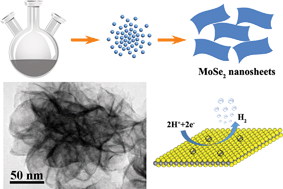Fast colloidal synthesis of scalable Mo-rich hierarchical ultrathin MoSe2−x nanosheets for high-performance hydrogen evolution†
Abstract
MoSe2 nanosheets have been extensively pursued due to the outstanding properties of this typical layered transition metal dichalcogenide (LTMD). In this work, we report a facile, fast strategy to synthesize scalable hierarchical ultrathin MoSe2−x (x ∼ 0.47) nanosheets. The nanosheets possess 2–5 Se–Mo–Se atomic layers and were synthesised through a bottom-up colloidal route within 20 mins under mild conditions from the reaction of MoO2(acac)2 with dibenzyl diselenide. The as-obtained hierarchical ultrathin MoSe2−x nanosheets are Mo-rich with a Se vacancy and show excellent HER performance with a small overpotential of ∼170 mV, large cathodic currents, and a Tafel slope of 98 mV per decade. Such high performance has been attributed to the unique structure of the Se vacancy defect, large surface area, as well as the enhanced conductivity. Meanwhile, the pathway can be extended as a general strategy to prepare other metal selenides, such as ultrathin WSe2 and SnSe nanosheets, and PbSe nanocrystals. It will also pave a new way to synthesize scalable nanostructured materials for intriguing nanodevices and large-scale applications.


 Please wait while we load your content...
Please wait while we load your content...